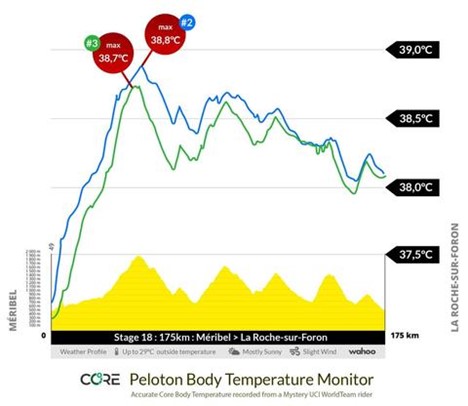Heat training – the poor man’s altitude training
A look at a new Core Body Temperature sensor and how to utilize heat training as part of your routine
 Photo by:
Getty Images
Photo by:
Getty Images
Over the past few weeks, I’ve had the opportunity to test the Core Body Temperature sensor. This sensor measures body temperature during training and competitions. This can be really useful if you are training for a race in a warm climate, or if you are doing a heat training protocol.
Heat training, whether it is done by training in a warm room or by spending time in a sauna, can be beneficial for your health and can even improve your performance. Heat training is sometimes called the poor man’s altitude training since it has similar benefits to training at altitude, and it is much cheaper than buying an altitude tent or doing a training camp thousands of feet above sea level. Benefits of heat training include: a better tolerance to working in hot conditions, better thermoregulatory capacity, an increase of plasma volume and an improvement in performance in both hot and cold climates.
In the past, I’ve used a similar sensor to measure my body temperature during triathlons in warm climates, such as Guadalupe. However, the two sensors I’ve used in the past were either a small sensor that I had to swallow, or a rectal sensor. The Core Body Temperature, however, is a sensor that you insert on your heart rate strap. It measures both your skin temperature and your core body temperature, and you can have access to the information live either on their phone application or on your GPS watch (it works with ANT+). Therefore, this sensor is much more user friendly that most temperature sensors. At first, I was unsure about the precision of this type of sensor compared to the conventional sensor, but many studies have compared it to other sensors and have shown that it is reliable.
Related: Why training in the heat is good
This sensor will be used by professional cycling team Bora-Hansgrohe next year and it is being used by Deceuninck Quick-Step this season. They have shared some data from a few Tour de France stages, and it is really interesting to see the body temperature increase when the intensity increases, for instance, while climbing. For example, during the 20th stage of the 2020 Tour de France, the time trial ending with the hill La Planche des Belles Filles, we can see the big increase in the body temperature when the cyclists are climbing.
Dan Lorang, who is the coach of Bora-Hansgroge cycling team, as well as the coach of current Ironman world champions Jan Frodeno and Anne Haug, used this product with his athletes. This device is also used by many pro triathletes such as Alistair Brownlee.
When trying to acclimate for a warm event or when doing heat training, monitoring your body temperature is really useful, because it is easy, especially at the beginning of an acclimatation protocol, to increase your body temperature too fast or too much and this can be detrimental for your training and even your health. I’ve personally made that error when training for Ironman Chattanooga a few years ago. I did a few six-hour trainer rides indoors without a fan and with a heater next to my face. I felt dizzy at the end and had to take a cold shower to feel better. By monitoring your core body temperature, you can make sure that you don’t go overboard (and I can tell you that it is really easy to go overboard with heat acclimatation). This allows you to adjust the temperature in the acclimatation room and the length and intensity of the training to maximize the benefits of the acclimatation training. As you get more acclimated you can increase the length and the intensity of the training in the acclimatation room, and you can also increase the temperature in the room.
Knowing your core body temperature during a competition is also really interesting because it allows you to make sure that you don’t push too much at the beginning of a hot race and overheat. If you see your body temperature increasing too much on the bike, you can try to cool yourself with cold water, drink more or if necessary slow down a little in order to keep your core body temperature stable. By slowing down a little bit on the bike and keeping your body temperature in control, you can possibly save a lot of time on the run because you’ll be able to run faster, or you won’t have to walk part of the marathon due to overheating.
Core body temperature has also developed an acclimatation test that you can do easily at home. All you need is a core body temperature sensor, a heart rate monitor and a power meter. During the warm up you slowly increase your power by small increments every 5 minutes from 50 % FTP to 80 % FTP, or until you reach a body temperature of 38°C. The intensity (power and heart rate) corresponding to when you reach 38°C is the checkpoint. Then you adjust the intensity so that you can maintain a constant heart rate. The test ends when your intensity is less than your checkpoint intensity minus 20 %. As you get more acclimatized you can increase the power reached at checkpoint, and you should be able to do the test for a longer time.
This device is not cheap; it costs $360.


